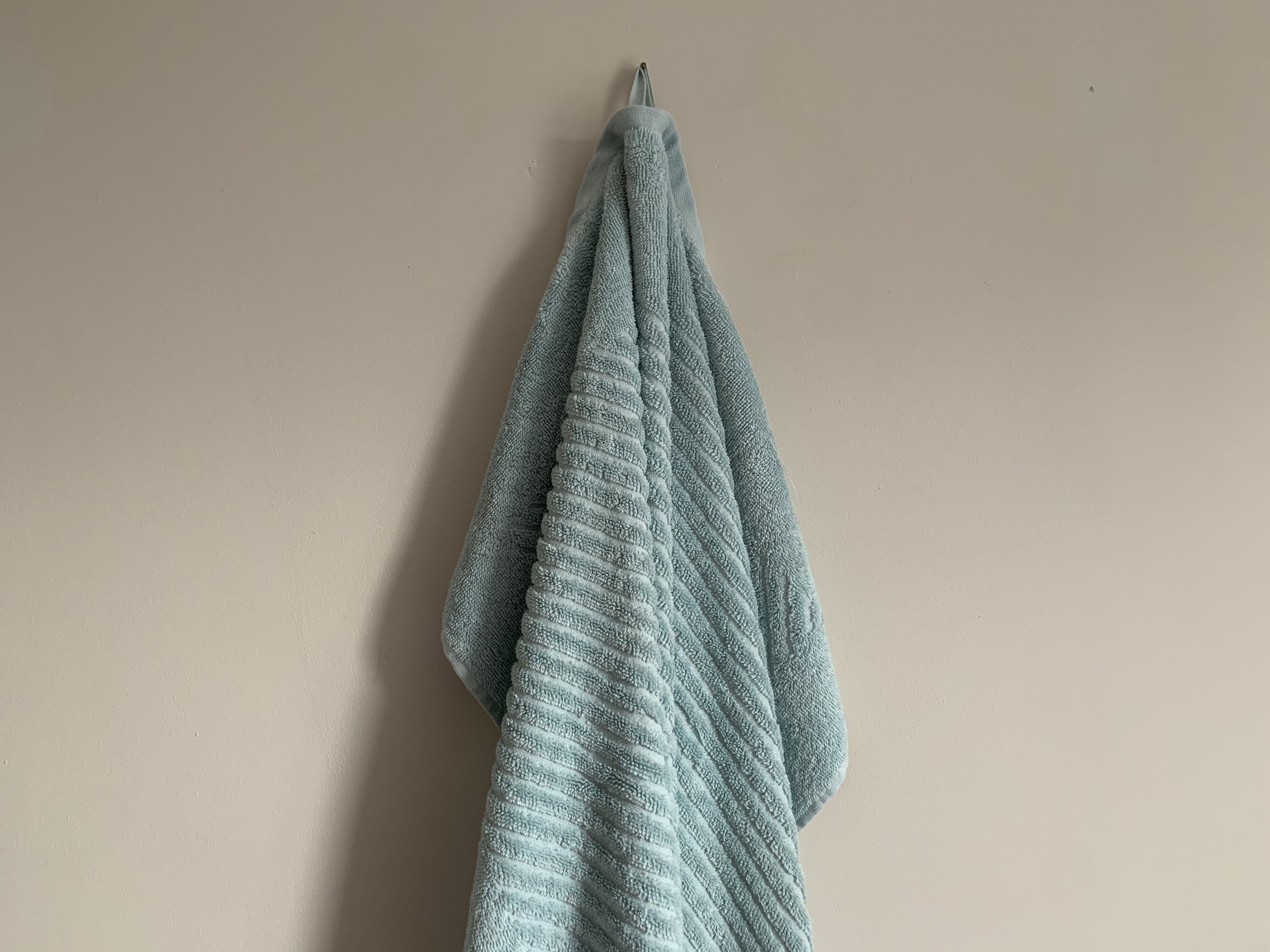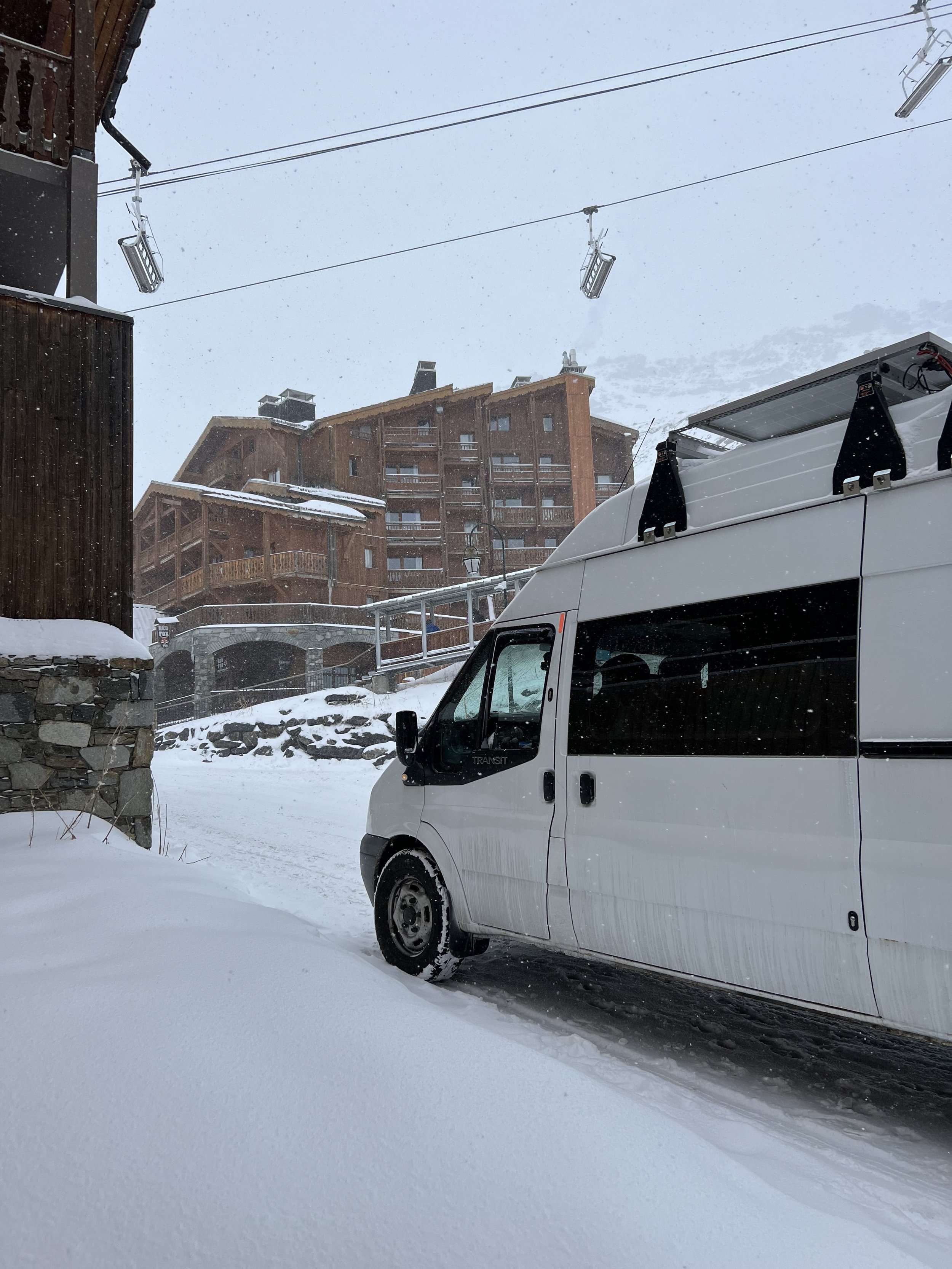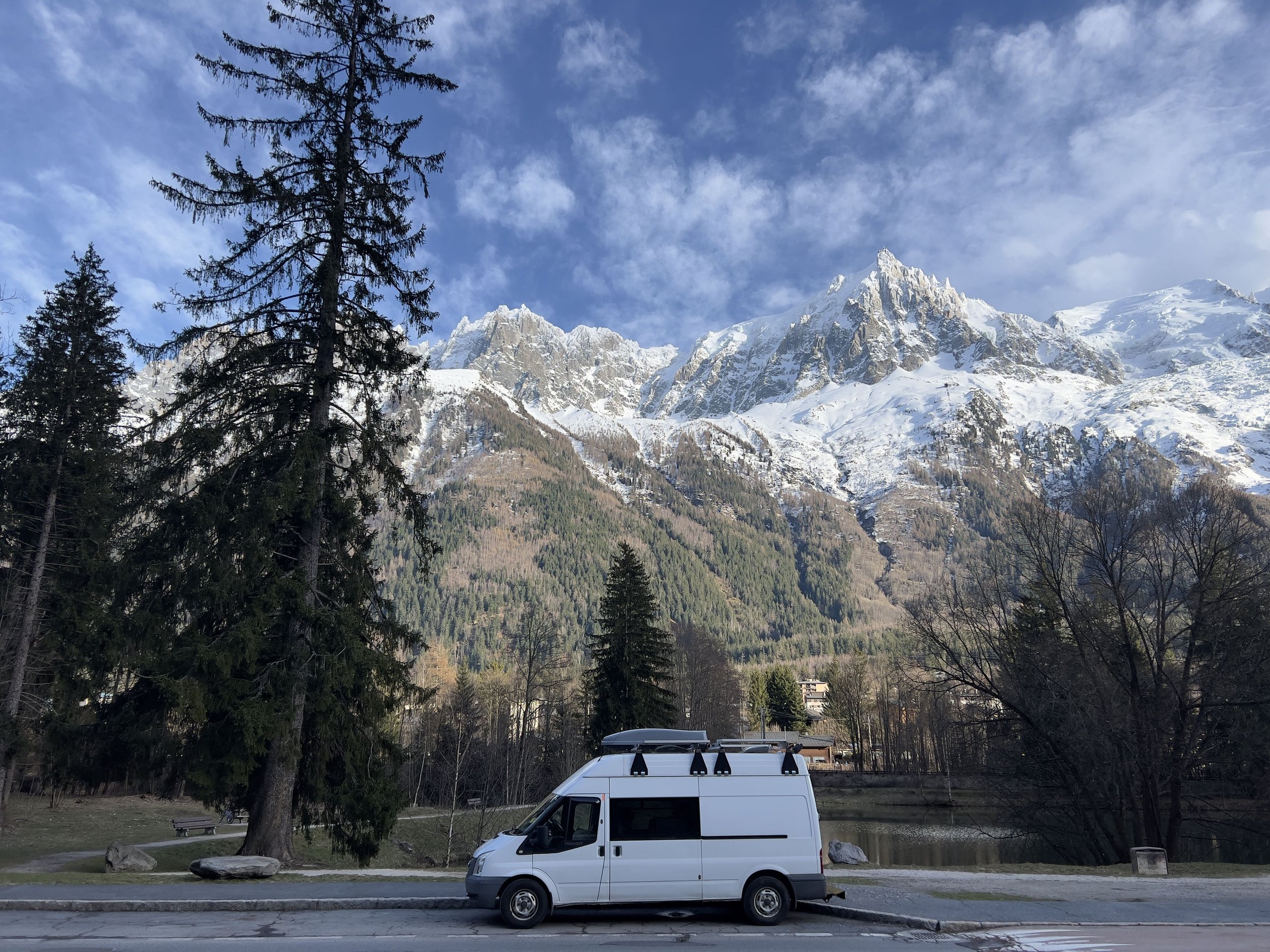Survive and thrive in winter van life with our 15 essential tips. From keeping warm with a diesel heater and wool blankets to managing condensation with window vacuums and dehumidifiers, learn how to stay cosy and handle freezing temperatures—even at -20°C in the Alps.
Updated January 2025
Waking up to a crisp, frosty morning can be a magical start to the day, but the reality of van life in winter can be pretty tough.
Winter weather means shorter days and colder temperatures, which can leave you feeling sluggish and can affect your mental health. Preparing your van with all the winter essentials is the key to surviving this time of year.
We've spent the last three years living in the van over the winter and discovered fundamental winter van life secrets that we will share with you!
As avid snowboarders, we have taken our van up to the highest ski resort in Europe, Val Thorens and to the Cairngorms in Scotland to spot wild Reindeer.
The lowest temperature we experienced during the winter was -20°C. After reading our top winter van life tips, anyone planning to live in their van or take a winter trip will be prepared for almost anything.
1. Window Vacuum
Even in a well-insulated camper van, you will experience condensation in the mornings after a night’s sleep in the van. This is from the warm air you breathe, reaching the van windows and turning into water condensation.
In the summer months, the air temperature is much warmer, and the sun will help to dry this moisture. We have tried moisture-absorbing bags, which help but don’t remove all the moisture on the windows, especially in winter. We also try to leave our windows slightly open to help, but we still end up with condensation.
One of the best things we have purchased is a water vacuum! Every morning when we get up, we vacuum all the condensation on the windows, and it’s all gone within minutes. It’s very satisfying to see it all disappear. The water collects in a clear plastic pot, which you can use to water your plants.
2. Window covers
In addition to a window vacuum, insulating window covers are a great way to reduce condensation and the amount of time spent wiping your windows. You can easily make your own, like we did, by glueing reflectix or thermawrap and stitching fabric on top.
We added magnets to the edges of our window covers. Some companies sell bespoke, ready-made window covers for specific van models; however, we couldn’t find any for our Ford Transit. The covers are fantastic for keeping heat out of the van on warmer days.
While we don't have a how-to video, this is a step-by-step guide for making your window covers from scratch.
3. Quick-drying towels
In the winter, you want to minimise the amount of moisture in your van to avoid any mould or damp issues. A quick-drying towel is a great idea for the winter, but also for the summer.
We have used microfibre towels, which are more compact than normal towels and are ideal for hiking, but we prefer soft, fluffy towels after a shower. We found quick-dry towels from M&S, which are an affordable option and come in some lovely colours.
The design and fabric type allow the towels to dry much quicker than normal towels, and it even comes with a handy hook, which is perfect for hanging up!
4. Diesel Heater
A dry heat source is the key to surviving winter van life. A heater will reduce condensation inside the van and allow you to dry wet clothes, stay warm, and reduce moisture levels.
It can be an expensive addition to get a heater installed in your van, but if you plan to live in it full-time or go on winter adventures for skiing, a diesel heater is a must-have.
There are a few different heating options out there; you could install a wood burner, but we didn’t have the room and wanted to limit the weight of the van. We installed a diesel heater, as it takes up a small amount of space in the van and provides a dry heat source that can instantly warm up the van at night or on chilly mornings.
There are two main diesel heater options, the German-made Webasto diesel heater (£1000+) and the Chinese-made diesel heater, which is around £100. Our diesel heater is connected to our fuel tank, which means we don’t have to worry about a separate fuel tank to fill up and use very little fuel.
If your camper van is petrol, then you will need to have a separate tank for the diesel heater. The heater is relatively small and doesn’t take up much room, which is a bonus, and the dry heat helps to reduce condensation.
When planning a ski trip to the mountains in your campervan, make sure to check whether your diesel heater can adapt to higher altitudes. Usually, you can change this within the settings and adjust it to the appropriate elevation, which will ensure the efficiency of your diesel heater.
5. dehumidifiers and fan
Ventilation in the van is really important to reducing the possibility of mould and damp. An important tip for winter van life is to turn on your roof fan when your dry heat source, the diesel heater, is running. This will lower the humidity levels inside your van and reduce condensation.
We have a Maxx Air fan at the front of our campervan, which works well for blowing air in and out. This creates a flow of air when combined with our roof window in the back.
An issue we had over the winter was our overhead storage cabinet. It became damp due to its lack of insulation, so we used dehumidifiers to lower moisture levels.
6. Hot shower
After a cold winter hike or ski, there’s nothing better than a hot shower! We didn’t have the budget or space to install a water heater. However, we came up with a cheaper solution for when we would like a hot shower. We boil our kettle and mix it with cold water into a bucket using a shower pump.
It works well, and you can also use it in the sink if you just want to wash your hair. During the winter, many campsites are closed, which can make it difficult to find a hot shower if you don’t have one in your van. There are some showers available at motorway services.
Another option in the winter is to get a gym membership to enjoy hot showers and get the added benefit of exercise, which is great for your mental health this time of year. Other places for hot showers include motorway services, swimming pools, and spas.
7. Wool blanket
Once the sun sets, the air temperature drops quickly. Even with a thick duvet, layers are key to keeping warm. When the nights reach below 0°C, a wool blanket on top of your duvet can instantly make you feel warmer. Wool resists water and is a natural insulator, preventing cold from reaching you.
A quality wool blanket will keep you warm and create a cosy feel in the van. We have a lovely blanket from So Cosy. These are natural, pure wool blankets with lovely colours and patterns. So Cosy is a sustainable brand that supports local communities by being upfront about where they source and manufacture.
So Cosy exclusively uses natural dyes to colour its blankets, and using only natural fibres is kinder to the environment because pure wool is 100% natural, renewable, sustainable, and biodegradable.
8. Fairy lights
Transform your van interior on a budget with warm, golden fairy lights. You may have heard of ‘hygge,’ a Danish and Norwegian word for a mood of cosiness and comfort with the feeling of wellness and happiness.
Scandinavians light candles to create a 'hygge' atmosphere in their homes, giving the place a peaceful and comfortable feel. After a day exploring outside in winter, there’s nothing better than a welcoming space that makes you feel at peace and helps you relax.
Candles and fairy lights are a lovely way to make your van feel welcoming when the sun goes down. We would recommend battery-operated candles and fairy lights, as real candles can be a fire risk if left unattended.
9. Hot Water Bottles
If you can’t afford a diesel heater and don’t have plans for a ski trip or extreme van winter adventure, hot water bottles are a great, cheap alternative.
Water bottles come in different shapes and sizes; a long water bottle is perfect for sleeping in bed to keep you warm during the night, which reduces the need for your diesel heater to run throughout the night.
We recently discovered Stoov hot water bottles, which are battery-powered and rechargeable, saving us from having to heat water.
10. Back up Power
We installed our vans roof solar pannels onto tilting brackets to make the most of the available sun during winter. However even then, the lack of sun can be a problem during the darker winter months.
In addition to your main power system, portable batteries are ideal for backup when there is no option to plug in your van and solar is low.
We use Bluetti portable batteries, which, depending on the spec you go for, offer multiple outlets and can keep you going till your next burst of solar or plugging into a mains charge.
We can plug our van directly into our Bluetti portable batteries to charge our van batteries, or use them on their own to power our laptops etc.
11. Snow chains or snow socks
In certain European countries, it’s mandatory to have snow chains or snow socks. When we arrived in Val Thorens, the roads were clear, and there hadn’t been any snowfall in the last few weeks. On our last day, a snowstorm arrived, leaving heavy snow on the roads and making it impossible to leave without snow chains or snow socks.
At the summit of Europe's highest ski resort, we understood our enormous mistake. Before leaving the UK, we did not check to see if the snow socks would fit over the tyres. Luckily, most stores in Val Thorens sell snow chains, and we managed to get safely down with them.
Don't worry; we make mistakes so you don't have to! Remember to check that your snow socks and snow chains fit your tyres. It's worthwhile learning how to put on snow chains, as we saw many others struggling for the first time.
Preparation is key! Even with snowploughs regularly clearing the roads, snow quickly covered the side roads, which demonstrated how important snow chains are for winter van life.
A final tip: before setting off on any journey, make sure to check the road conditions and be prepared for ice and snow when going on a ski trip.
12. Wind deflectors
This might not be the first thing that comes to mind during the colder months, but wind deflectors are a useful addition to your winter survival kit.
As mentioned above, ventilation is key to reducing humidity and moisture inside the van, and wind deflectors allow you to crack open the windows to allow airflow without letting rain inside. You may notice the inside of the van steams rapidly when it rains, and this trick is great for keeping moisture levels low.
Of course, they are also great for summer, but we noticed our wind deflectors were a little too big and created a bit of a blind spot, so we would suggest getting the thinnest possible.
13. Indoor washing line
There were many times we would wash our clothes at the laundrette only to find they still hadn’t dried completely and couldn’t stay the night. We realised how handy it was to have an indoor washing line not just for ‘almost-dry’ clothes, but also for towels and snow gear after a day outside.
An easy way to make an indoor washing line is to drill hooks or place strong wetsuit magnetic hooks on either side of your van and then put strong rope from one side of the van to the other. The only thing is that it will make your van feel quite cramped when everything is drying, but it's worth it for nice dry gear for the next day.
14. Engine cover or blanket
On a cold morning, it would sometimes take a while for the van to start up. After speaking to several other van lifers who regularly come to the mountains to ski, they mentioned getting an engine blanket.
If you are parked in a camping aire or campsite, placing a blanket over the bonnet of the van will help with thermal insulation and keep heat inside, preventing the engine from getting too cold.
15. A Bucket
We’ve saved the best till last, and yes, it’s a bucket. A bucket or large bowl will do wonders in freezing temperatures. To avoid your pipes from freezing and splitting, place a bucket where your wastewater empties and leave the tap open overnight.
We first noticed buckets under vans while staying overnight in the Les Menuires ski resort campervan aire and realised it was an essential trick for keeping your pipes from freezing and avoiding any damage.
WATCH OUR VAN Life winter series ON YOUTUBE
This post may contain affiliate links, which means if you purchase through these links, we may receive a small commission at no cost to you. Thank you for supporting our website.
























